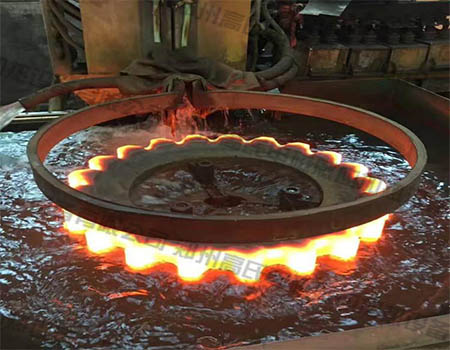In general, the workpiece needs to be tempered with a high-frequency induction heating machine after quenching, so that certain mechanical properties can be obtained. Tempering not only improves the plasticity and toughness of the workpiece, but also reduces the quenching stress generated inside it, ensuring the dimensional stability of the workpiece. If tempering is not carried out in time within the specified temperature range, surface cracks or fractures may occur for some workpieces with high hardenability. At this time, we need to perform rapid tempering treatment and reheat the workpiece to The temperature at the eutectoid point further reduces its hardness and increases its toughness. The entire tempering process is also called the precipitation process of carbon in martensite, and it is divided into four stages. Let me introduce it to you below.
1. When the high-frequency induction heating machine starts to heat, the internal tissue lattice of the workpiece shrinks slowly, and carbon will be precipitated at the intersection. In the flaky martensite, the carbon atoms will appear in groups, and the volume will also shrink.
2. When further heating, the residual austenite is decomposed into bainite, ferrite and carbide. There will be carbide precipitation in the middle of the lattice. At higher temperatures, the bainite structure contains ferrite and cementite, and at lower temperatures, the bainite structure contains ferrite and carbides. So at this stage, the main determinants of the transformation of retained austenite are temperature and time. During the transformation, the crystal lattice becomes larger, or other dimensions change.
3. At this time, the temperature reached 230°C, and ferrite and cementite precipitated. The internal tissue lattice will shrink and become smaller. For workpieces with low carbon content, the amount of shrinkage can be very high.
4. In the last stage, the tempering temperature is 350°C. The cementite particles become spheroidized, which indirectly leads to larger cementite and ferrite grains. During the tempering process, the volume of iron atoms between the martensite in the quenched state and the martensite in the tempered state changes accordingly, thereby inducing a change in the size of the workpiece. This resulting strain is called tempering strain. Therefore, it is very necessary to strictly control the size of the workpiece during the heat treatment process of the high-frequency induction heating machine.




 en
en  cn
cn  jp
jp  ko
ko  de
de  es
es  it
it  ru
ru  pt
pt  vi
vi  th
th  pl
pl 







 GS-ZP-1200
GS-ZP-1200


